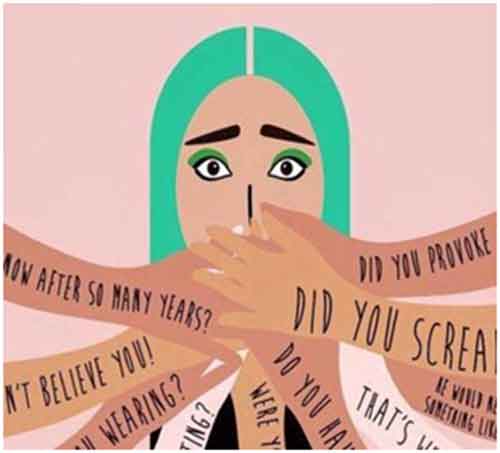
“We don’t need Afghan-style burqas to disappear as women. We disappear in reverse – by revamping and revealing our bodies to meet the externally imposed vision of beauty” – Robin Gerber
Existentialists argue that everything we are today is the result of our choices, and we build our own values with the available choices and resources that society gives us. But what if these choices are results of manipulation? In The Second Sex, Simone de Beauvoir presented a perplexing image of freedom, where women struggle against their own bodies, and she describes how society works as an agent to shape this struggle.
As girls hit puberty, the society starts being hostile to their maturing body, and gradually they become a “flesh”. Mothers, aunts, and school teachers start criticizing our bodies and postures. They always remind us to cover up, be ladylike, be presentable, ultimately making us self-conscious. We all have been catcalled, teased, molested or even raped, and these experiences made us feel ashamed about our bodies. Even the cuss words are always cursing the female bodyparts! In this whole process, girls are gradually conditioned to view themselves as objects to be monitored at and assessed based on their appearance and gait. This is the process of self-objectification where women internalizes other people’s perspective toward their own body and habitually monitor their appearance as per the public or private standards. They yearn for catering to the dominant culture that tends to objectify women.
With the inception of property and society, women lost control over their own body and in the system, they were positioned as “sacred”, “pure”. Myths like virginity was invented by society to control women and their bodies. In sanskaari post-colonial Indian society, women are expected to deny western influences and maintain a particular form of femininity that is rooted in the spiritual, self-sacrificial heritage of being an ideal Bhartiya woman. Needless to say, these women need to have long hair, fair skin and an hourglass thin slim body. Typically, these beliefs have been flourishing due to the objectifying mass media, such as magazines, television, and films. The popular culture also consumerizes women’s body to cater to the male psyche tickling sensual pleasure. Yet, they retain a dominant patriarchal shade with an emphasis on traditional normative practices to induce overtly or covertly the ideal image of women. Thus the imposition of beauty standards goes hand in hand with the age-old socio-culturally milieu.
Negative body image is not an Indian archetype. Women from different ethnicities are dissatisfied with their bodies, and many are dieting to lose weight. Thinner body ideals are now being reinforced for all women, regardless of culture and ethnicity. Thereby the vulnerability towards developing greater body surveillance and a negative body image are increasing. A booming industry of skin-lightening products, vagina-tightening gel, the plastic surgery industry, indicates the presence of negative body image in India.
The influx of western companies in the late 1990s like L’Oreal, Christian Dior and Tommy Hilfiger, drastically affected the fashion industry and have further moulded the ideals of already distorted shape and size. The winners of the most coveted global beauty pageants became an epitome of the confidence and poise. It was the ultra-thin plastic bodies of the contestants that set the standard for every woman in glamour industries, which perpetuated into the modern urban Indian women.
Social media, a bridge that connects individuals and society, deeply effects people’s daily life. When social media start asking women to physically fix their appearance, it gives women a message to self-objectify. In fact, a few studies have shown that increasing exposure to objectifying media and images might lead to body self-objectification by individuals. Women are expected to be thin at the time of marriage. We all know how Radhika Apte lost a film (Vicky donor) because she was “overweight by a few kilos“. Magazines have been providing tips on right clothing, eating and exercise to Indian women since forever. The main topics on the magazines are always about the theme of Beauty Myth, such as dieting, beauty products, or how to be an all-rounder who could balance both home and office. In India, even female politicians are judged on looks, with articles describing “most beautiful female politicians“. Then there are people making fun of the politicians who don’t fall into the category of the beauty standards set by media.
Let’s talk about little girls. We all know some aunts or some mothers who would rub home remedies for darker hair and fairer skin for girl children. Then comes Barbie as an aspirational role model epitomizing an unrealistically thin body ideal damaging girls’ body image. It is indeed reported that little girls exposed to Barbie have lower body esteem and a greater desire for slimmer body shape.
Apart from the ultra-thin figure, standards of beauty were set by the portrayal of body-hair free, smooth-skinned, shiny hair models in Indian TV advertisements. Physical appearance is essential for both males and females, and models in advertisements affect both the genders. However, various researches have shown that beauty as the core feature of femininity is portrayed by the media, and girls experience more significant negative body image and lower self-esteem than boys. Women who fall short of unrealistic ideals often feel vulnerable, and they struggle between the blurry lines of real and ideal beauty. It can lead to excessive exercise, unnecessary surgical intervention, unhealthy skin bleaching, unhealthy dieting, eating disorders. Apart from mental health, these lifestyle choices hugely affect physical health and social functioning.
The social cognitive theory also suggests that social learning occurs from one’s immediate environment. A vast amount of information about human values, thinking, and behavior patterns is gained from the symbolic environment of the mass media. Father of social psychology, Bandura suggest that viewers’ perception is enhanced by exposure to media. Thus, body positivity can be propagated by the media itself by incorporating diversity, appreciating the uniqueness of each and every body types, rejecting the aspects of societally-prescribed ideals, emphasising the body’s functionality rather than aesthetics. Definitions of beauty should never be restricted to a dominant idea. Awareness about the negative impacts of objectification, not only helps people to become a better self but also improves society as a whole. When more women realize the causes and effects of objectification, they will build self-cognition and believe in themselves as a human and not flesh.
Dr Tuli Bakshi, Postdoctoral Fellow, Department of Earth Science, Indian Institute of Technology, Bombay
SIGN UP FOR COUNTERCURRENTS DAILY NEWSLETTER















































